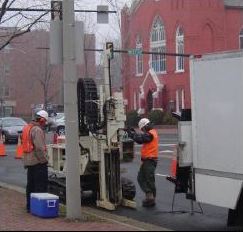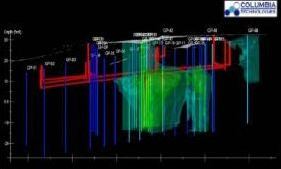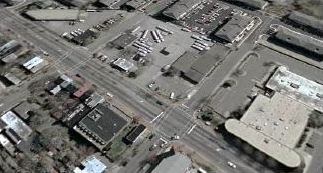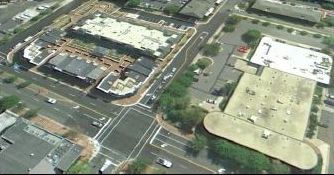 |
 |
 |
 |
 |
 |
 |
 |
 |
 |
 |
Triad Principles Applied at the Fannon Petroleum Site in Alexandria, VirginiaSite BackgroundIn 1962, a petroleum bulk terminal was built on Duke Street in Alexandria, VA. The terminal had aboveground storage tanks (AST) and underground storage tanks (UST) totaling over half million gallon capacity storage and was serviced by a railroad line that ran through the back of the property. In 1982, a large amount of oil was discovered during excavation activities on a utility line a few blocks from the site. The release was reported to the state water control board and ultimately linked to the bulk terminal. Contamination at the site was addressed by the responsible party through the use of recovery wells while the site continued to be used as a terminal. By 1985, over 27,000 gallons of product had been recovered. Early in 2000, the area around the site was being redeveloped. The rail line had been removed and condominiums and townhomes were built adjacent to the site property. Efforts to address the contamination were ongoing, but contaminant concentrations remained at levels that presented a high risk. The Virginia Department of Environmental Quality decided to try a different approach to the site and worked with the responsible party (Fannon Petroleum Services, Inc.), the City of Alexandria, a redeveloper (Van Metre Homes), the adjacent property (Shiloh Baptist Church), neighbors and citizens to relocate the terminal, cleanup the site and redevelop it for residential use. This process was supported by Triad approach best management practices including: systematic planning, real-time measurement technologies and a dynamic work strategy (DWS). Systematic planning - Before use as a petroleum bulk terminal, the site had been used as a terminal for other fuel (such as coal) since the late 1800s. Because of the long history of the site and its integration within the area, systematic planning was used to engage all stakeholders and facilitate collaborative decision-making. The systematic planning process included the development of a conceptual site model (CSM), identification of actions required to characterize the site completely and development of a new corrective action plan which was continuously updated. Stakeholders collectively decided to use:

Figure 1. Performance of the MIP Survey Dynamic work strategy - A DWS was developed to update the MIP survey plan continuously as real-time data was collected and analyzed. This allowed the site team to identify additional sampling locations as appropriate while in the field and allowed for the completion of the survey in one event, including the delineation of a new plume lobe that was discovered during the investigation. Real-time measurement technologies - A direct-sensing MIP was used to:

Figure 2. Results of the MIP survey shown as a three-dimensional visualization. Data were provided in real-time which allowed the site team to evaluate and make decisions while in the field. Additionally, MIP survey results were provided to site stakeholders using three-dimensional visualizations helping them to comprehend the extent of contamination at the site and associated risk scenarios; this facilitated collaboration and active decision making. Site ProgressThe fully-developed CSM allowed stakeholders to reach an agreement on an appropriate remedial strategy and residential redevelopment plan. Risk based cleanup goals were used to develop the remedial strategy which included:
Residential development of the site into 18 townhomes and 40 condominiums with a below-grade parking structure was completed in 2010. To support redevelopment, the soil vapor extraction system and pump & treat systems which were originally located on the site were moved to an adjacent property. By March 2011 the pump & treat system had recovered an estimated 5,000 gallons of petroleum and removed nearly 7,000 pounds of petroleum vapors from the subsurface. The remediation system will continue to operate until risk-based clean-up goals are met.

Figure 3. Aerial photo of the site during use as a bulk terminal. 
Figure 4. Aerial photo of the site after redevelopment. References: Chapman, Randy, and Daniel Imig. 2011. "Revised Characterization Plan Accelerates Petroleum." Technology News and Trends. Pages 1-3. March 11. Accessed in December 2013 at: http://www.clu-in.org/products/newsltrs/tnandt/view.cfm?issue=0311.cfm#1. EPA. 2010. "Real-time Delineation of a Free Product Fuel and Groundwater Contamination Using a Membrane Interface Probe at the Fannon Oil Site, Alexandria, Virginia." Triad Project Profile. November 13. 2010. Accessed in December 2013 at: http://triadcentral.org/user/includes/dsp_profile.cfm?Project_ID=40. EPA. 2010. "Implementation of Triad for Petroleum Brownfield's Cleanup and Reuse." January 26. Accessed in December 2013 at: http://www.clu-in.org/conf/tio/fannon_012610/ |
| Home | Introduction | Background | Case Studies | Best Practices | References FAQ | Glossary | Internet Resources | Contacts Privacy/Security | Site Index |